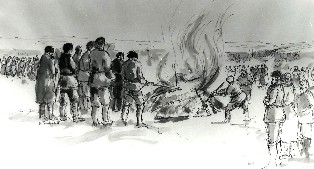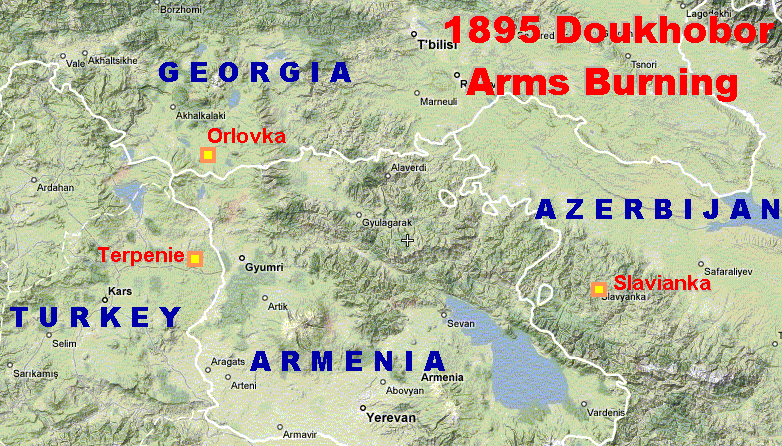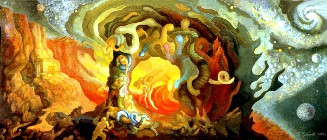The Events That Shook the World in 1895
by Koozma J. Tarasoff, Ottawa, OntarioAn article for Ahimsa Nonviolence, International Gandhian Institute for Nonviolence and Peace (IGINP), Tamil Nadu, India.
Tarasoff, Koozma J. ‘The Events That Shook The World in 1895’, Ahimsa Nonviolence, Vol. II, No. 3, May-June 2006: 244-246.
My debut to your magazine was stimulated by my Gandhian friends Glenn D. Paige(1) of Hawaii and Bill Bhaneja of Ottawa, Canada. Both of my friends have gone against the grain of prevailing values and institutions and have provided an alternative way of looking at the world. This is the nonkilling global paradigm which asks the profound question: ‘Is a nonkilling society possible?’
To me the nonkilling global idea has special meaning because it closely relates to my Russian ancestors the Doukhobors who in 1895 literally shook the world with their manifestations for a peaceful civilization(2). The first act took place in Easter 1895 in the Transcaucasian territory of Elizavetpol. Matvey Lebedev and ten other Doukhobors threw down their guns while training in a local reserve battalion. They said that war and moral behaviour are incompatible. The result was the dissidents were sent to a disciplinary battalion and exiled along with 60 other young men in active service who followed their example.

The Historic Doukhobor 1895 Arms burning sketch by William Perehudoff, artist from Saskatoon, Saskatchewan, Canada. The image was first used in Koozma J. Tarasoff’s Pictorial History of the Doukhobors (Saskatoon: Prairie Books Division, Modern Press, 1969). Image No. 372_25. Copyright reserved by Koozma J. Tarasoff.
The second act literally shook the world. It took place midnight June 28-29 (old style Julian calendar; new style Gregorian calendar is 11-12 July), 1895 in three settlements of Transcaucasia, between the Black and Caspian Seas — Orlovka village, Tiflis province now in Georgia; Slavanka village, Elizavetpol' province now in Azerbaijan; and Terpenie village, Kars province now in Turkey.
When 7000 Doukhobors simultaneously set ablaze their rifles, pistols and swords in the first mass protest in history against war and militarism. What a spectacle this was! What a dilemma for the authorities! The reaction was swift.

Doukhobors in Orlovka, Bogdanovka area of Tiflis district [now Georgia] received the most severe beatings, floggings and exile of 4,600 to Gori, Signak, Tianeti, Dusheti, and Skra. And those 300 who handed in their military reserve papers and refused to accept the gun and the oath of allegiance to the Tsar as well as refused to go on a church parade, were exiled to Baku, Yerevan and Elizavetpol. To go against the church and the state was treasonous.
Thanks to the assistance of world-renowned writer Lev N. Tolstoy along with Russian intellectuals and the Society of Friends (Quakers), the more persecuted Doukhobors were saved the fate of extinction. In 1899, some 7,500 Doukhobor dissidents were exiled to Canada and some 40,000 of their offspring reside here to this day. A similar number reside in Russia and about 500 in the USA. Doukhobors continue to annually commemorate the 1895 acts as heroic, pioneering, and as the only alternative to the creation of a nonkilling society.
Today, in the 21st Century, amidst the memory of 9/11, the ongoing violence in Iraq and Afghanistan, the terror of Israeli/Palestine war, and many other zones of violence, the bloody institution of militarism and war begs the question: ‘Why should people continue to suffer and die at the hands of fellow human beings because some general or head of state says so?’ Is this because of greedy politicians and business people who seek power, money, oil, or revenge?
I recall that Gandhi once said: ‘An eye for an eye leaves the whole world blind.’ Also a wise Chinese proverb makes a complementary statement: ‘If you want to take revenge on somebody, you better dig two graves.’
Surely civilization can do better. Are we not endowed with consciousness, reason, and creativity that enable us to find a ‘win-win’ outcome? My ancestors said that the Spirit Within is the Spirit of God which disallows us to kill another human being. They accepted the commandment of ‘Thou shalt not kill’ as an integral part of our being.
‘It’s utopian’ said a friend to me when the question of the possibility of a society without wars and the institution of militarism was posed. ‘Is it utopian?’ I thought to myself. Or is it completely possible?
With the global resources of the spirit, science, institution and experience, surely we can invent alternative ways of dealing with our problems than relying on the terrible institution of legalized slaughter of human citizens? Since wars begin in the minds of men, peace also begins in our minds. Surely we can prevent the killing of billions of our fellow beings and instead turn our resources to making an enriched living for the masses.

Arms Burning Mural triptych oil on canvas 100 x 200 cm. Created in 1995 by Vladimir Gubanov of Russia in commemorating the 100th year anniversary of the 1895 arms burning in Russia. This work took the artist nearly three years of research and work. He studied astronomy, science, and physics. Vladimir describes this work as follows: ‘It characterizes a romantic view of the burning of guns near the village of Orlovka in Bogdanovskoi Raion, Georgia. The image depicts the struggle between the forces of good and the forces of evil. In the first plan, there is perturbance (disturbance or agitation), and the site of burning of arms. In the lower place, is the sun – the centre of creation. On the right side, at the edge, is the earth. There is a moon, Jupiter, Mars, and Saturn. The colours have significance. Light colours are for the sun in the centre and its rays fill the whole. The perturbance relates to the worms and snakes which characterize evil….In front is a person who lights the fire. Next is a person who struggles for life. Higher up is a man who has fallen to evil. Higher up still is a man in the process of transformation between one form and another. On the bottom, right, is the city, churches, and homes…. Doukhobors are separated from the main civilization. If the wrestler stops, this may cause an effect on the whole universe. Lower left shows a view of people carrying torches – they point the way to action. Women hug their children and save them.’(4)
The two images of the historic 1895 arms burning were recreated by Doukhobor artists. © All rights reserved by the Koozma J. Tarasoff, 2002.
I am indebted to Dr. Glenn D. Paige in searching for the spiritual, philosophical, ethical, moral, humanitarian, and political reasons for refusal to kill. In so doing, he has given us the tools of hope. He has developed the concept of a nonkilling society, with practical examples of how even now it is plausible for us to envision a society without killing that is not a product of hypothetical speculation, but is based upon demonstrated human experience.
Of the many examples of appropriate structures and projects that support the creation of future nonkilling societies(3), my ancestors the pacifist Doukhobors were mentioned along with the Quakers, the Fellowship of Reconciliation, as well as many other sources of inspiration:
- Economic institutions (such as the Vinoba
Bhave
land trusteeship movement);
- Educational institutions (e.g. Gandhigram
Rural Institute in India);
- Training institutions and research journals (e.g.
The Albert
Einstein Institution, Cambridge,
Massachusetts, founded by Gene Sharp; Peace News: for
nonviolent revolution, London; the International
Journal of Nonviolence, and Nonviolent
Activist.
- Cultural resources (e.g. folk songs such as ‘We
Shall Overcome’, and films);
- Nonviolent political struggles (e.g. Gandhian
independence movement in India, the anti-nuclear war
movement, conscientious objection to military
service, end war taxes, abolish land mines, a
coalition against arms trade, etc.);
- Historic roots (such as those of Doukhobors,
Quakers,
and Mennonites);
and
- Biographies of brave humankind such as George
Fox, Mohandas
K. Gandhi, Martin
Luther
King, Jr., Lev
N. Tolstoy, Adin
Ballou, Henry
David Thoreau, A.
J. Muste, and Dorothy
Day.
References
- Glenn D. Paige.
Nonkilling
Global Political Science.
Xlibris Corporation, 2002. Dr. Paige is professor
emeritus of political science, University of
Hawaii, and the founder and president of the
nonprofit Center
Global Nonviolence in Honolulu.
- Koozma J. Tarasoff. Spirit
Wrestlers: Doukhobor Pioneers’ Strategies
for Living. Ottawa, Canada:
Legas Publishing and Spirit Wrestlers Publishing,
2002.
- Paige, 2002: 48-69.
- Tarasoff, 2002: 224.
More about the Doukhobor 1895 arms burning:
- 'The Burning of Arms, June 1985, and "The Execution"', Chapter V, Pages 57-64 of Christian Martyrdom in Russia: Persecution of the Spirit-Wrestlers (or Doukhobortsi) in the Caucasus, edited by Vladimir Tchertkoff, 1897, London.
- Historic 1895
Burning of Guns Descriptions: Selections and
translations
- The Doukhobor Peace Day, Doukhobor Genealogy Website
- This Sunday marks 109 years since the burning of weapons, Castlegar Citizen, 23 June 2004, page 6
- Want a real Easter message? Burn your guns, Vancouver Sun, (no date) by Stephen Hume
- The
weapons burning of 1895, Peace News, Issue
2391, June 1995 (adapted from Ploughshares
Monitor)
- Gregory Vanin – Refusal of Military Service, Doukhobor Genealogy Website by Jonathan Kalmakoff
- Appeal for Help, Doukhobor Genealogy Website by Jonathan Kalmakoff